Diary of an Unemployed Class of '10 Philosophy Major in New York City, Part 4
by Sam Biddle
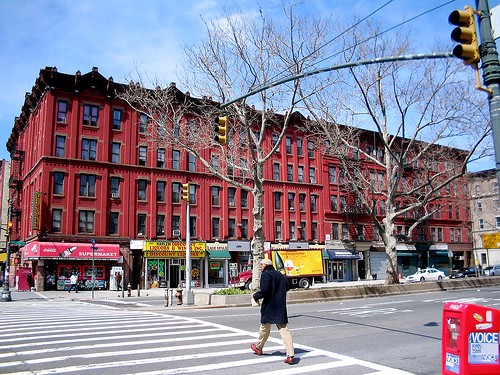
Is it petty to not share in the happiness of someone else’s success? Is it petty to wish-to beg, even, knuckles blistering, eyes bloodshot, beseeching each god-for their horrific downfall? Is it immature to consider another’s achievement, to imagine them doing the job you wish you had-walking around in your fancy pants, sleeping with your wife in your own bedroom, eating your Frosted Mini Wheats, loudly slurping the milk-and sink into despair? Is this unfair? Should this be beneath me? I woke up in an un-air-conditioned lethargy this morning and, as I have for the past several years, rolled over to open my laptop.
You. Bearer of bad news. Barer of breasts. I hovered over the seventeen or so tabs of Facebook I had open from the night before and, having selected one, eased into inoculating myself against the day’s coming annoyances. Girls’ phones, lost, drowned in so many toilets. Send me your numbers, QTs! A sullen she-bro from Long Island sharing her low resolution photo of a car. An idiot and his lone, cloying Tweet about soccer. What a sweet and noxious cocktail the mix of Facebook and Twitter statuses makes for-like grenadine and clorox, or Hitler and Mussolini waltzing. That’s enough news for this morning, so-wait.
And there I saw it. J___ had shared something. What a sad mess of sharing Facebook has made. What sharing once meant, what virtue it once stood for. Here, I have a piece of key lime pie. Would you like some? I will share it with you. But now-HERE, DO YOU WANT TO SEE WHAT PICTURE I TOOK ON MY PHONE TODAY? LET ME ~*~*SHARE~*~* IT WITH YOU. LET ME SHARE SOME FRESH PEPPER, GROUND DIRECTLY INTO YOUR EYEBALL. J___ had shared an article she wrote. Her article. Her words. Her… byline. I hadn’t seen her name above text since we dated and I used to help edit pieces she wrote for our high school paper. They would be about assemblies, and carpools. And now they are about high art.
I groaned and the hot wind in my chest rattled and I hated my apartment’s stupid crooked floors and how I didn’t have any socks. I thought about the fact that I had probably overdrawn yesterday when I bought that iced tea-overdrawn so far, so deep down into the red that it would take an array of advanced financial algorithms to sort out how many fines to apply to my account. An oversized alarm probably sounded at Bank of America headquarters, and confetti dumped down from the ceiling, and all the analysts hooted and yelled and kissed, “I can’t believe the kid did it again! Unbelievable!” I read her article and it was very good. I hovered over her name and thought about clicking and congratulating her, but I didn’t want to come across as depleted and insincere, which I was.
I stepped out of my bedroom and the cooler air felt good. If there is something that is the opposite of sex, the apartment reeked of it. I dressed quickly, crept past R___’s crumpled, corpse-like form on the futon to pick up my sneakers-the first rays of noon slapping at his grimacing face-and pretended I had an errand to run down on Houston. If anyone pressed me I’d say I was going to go print out a few copies of my resume. Ha! Poor little sheet. Sometimes I compulsively check my resume, scouring it for some overlooked explanation of how often it’s ignored. Perhaps I introduced an inadvertent racial slur? Did I include overt Freemason symbolism? Is “FUCK ALL JOBS & EMPLOYERS” written in tiny type at the bottom? As I walked past 1st Avenue, I noticed a crowd formed across the street around a chicly dilapidated theater. I thought maybe it was something neat like a firing squad or a zany “flashmob” type iPhone thing. Oh, well, no, it was some sort of red carpet event. Was I late?
An impossibly tall, grinning, heron-like woman clothed in a matte black trapezoid shimmered in the light of the sloppy sun and waved from behind a barricade. My shirt smelled like ramen seasoning powder in the humid wind. She was standing in front of one of those walls with patterned logos on it that awful people pose before to be photographed at momentous occasions like the launching of a handbag line. I remembered last summer, when L___ told me about his friend’s fundraiser for “nightlife preservation” in New York-is there any way to place something like that in more than one set of quotation marks? I imagine there were a lot of red carpet logo walls there. I thought of this now and closed my eyes and faced the gut-punching sun and thought about how it’s supposed to burn out in a trillion years or whatever, and how maybe that could come a little sooner and it wouldn’t be so bad.
There is actually an industry term for these red carpet backdrops, and I remember stumbling upon it for the first time a few months ago, and then feeling a bit lightheaded as my brain strained, in desperate cognitive self-preservation, to purge this awful factoid. I was glad I couldn’t recall. There’s really no excuse for anyone to ever know this word. The crowd craned their heads, a thousand Wayfarers creaked in unison, and an ecology of LCD devices shot up for a better look-but no phone was smart enough to identify this glamor-ridden anonymous giantess. Her very atoms were animated by the recognition of the crowd. Her skin gleamed and her eyes flashed with a terrible shine. Look on my shins, ye Mighty, and despair. Did anyone know who she was? The starers strained further. A small pale man in a cream hat, turning away from the red carpet colossus, murmured to a young flat-chested woman with him, “there’s an app for that!” and smirked. O, to have a flamethrower in New York.
I rounded the corner in a hurry because, really, that shit was just the worst. I thought about foraging for pizza somewhere, and began to roam. Sometimes my employed friends remark, charitably, how nice it must be to be without a job and free during the day, and walk wherever and whenever I want. To be free! A comment analogous to saying how nice it must be to have no hands, what with saving so much on the cost of mittens and all. A weeping willow’s tentacle brushed against my face, and I let it, without tilting away. I’m always told that to fit in here, you ought never look upward-it betrays a delight with one’s surroundings that natives find unsavory. But it was a beautiful, enormous tree, and I looked it up and down, and smiled at the babies sitting underneath it in the hazy shade, then immediately stopped because I didn’t want anyone to see this guy with savage hair and a beard staring at their baby. Walking further, I passed a gaunt couple walking two healthy looking dogs. They were cheery in spite of their sickliness, perhaps owing to their fine linen outfits, or having been freshly exhumed that afternoon.
“Yeah, I know, it’s just-”
“Well I’ll tell you what it is,” the stately heroin wraith replied with a yawn. “It’s just that DOING NOTHING is so TIII-IIIRING. Just sitting DOWN! It’s just so HARD! I’m exhaa-aausted!”
They smiled at each other and one of the dogs chirped a bit and I wondered whether I had held my face up to the sun for too long earlier. I walked briskly back home and congratulated J___.
Previously: Diary of an Unemployed Class of ’10 Philosophy Major in New York City, Part 3
Sam Biddle is a recent college graduate in New York City.
Photo by AlPie, from Flickr.
Notes from an FX Trader: On Genius, Idiocy and the Merely Intelligent
by The Green Manalishi
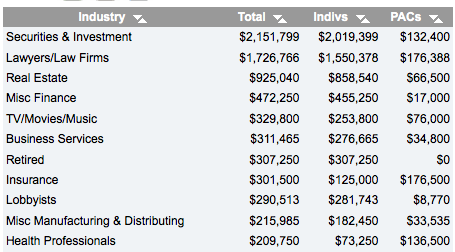
“An intelligent person will only make money from other intelligent people. But a true genius will make a fortune off all kinds of idiots.” -Dr. Frederick C. Evering
When Dr. Evering first articulated his Theory of Genius and Idiocy (TOGAI, I guess), Steve Jobs, Rupert Murdoch and Oprah Winfrey had only just begun establishing spaces in the socio-culturescape; Reality TV was just emerging from the womb in the form of MTV’s “Real World”; and the letter-word combo “P-Diddy” was nothing more than shorthand for “I have to take a piss” to those either barely out of the crib or legitimately speech-afflicted. The year was 1993, and what was on Dr. Evering’s mind was the new Dodge Intrepid he had just bought, fully tricked out with neon undercarriage, heated seats and Knight Rider-esque voice reminders to close the door and switch off the lights.
He soon realized such extras were hardly worth the expense, hence the TOGAI epiphany. From my 19-year old standpoint, I was amused by an elderly scholar, a man who liked to remind us that he had “been teaching Electrical Engineering since the Eisenhower administration,” openly implying that he was unsure of whether to consider himself intelligent or an idiot (that he did not qualify as a genius according to his theory goes without saying).
For sure, the Intrepid provided ample fodder for his inevitable trips off-topic both in and out of class and what Dr. Evering-my sophomore year EE101 professor-liked more than anything was getting off the stoic topic of electrical network analysis and on to the far more compelling topic of life. So I dropped by during his office hours one afternoon to see where next he could go with intelligence, genius, idiocy and the fiduciary relationships binding them together.
“Ever heard of George Soros?” he asked, when I explained why I came by. I shook my head. Dr. Evering explained how Soros had made out with a fortune shorting the British pound the year before, thereby forcing the Bank of England to abandon the European Exchange Rate Mechanism (the precursor to the euro); Dr. Evering then proceeded to compare the whole ordeal wrought upon early 90s British monetary policy to a voltage drop in an electrical circuit-as only a professor who had been teaching Electrical Engineering since the Eisenhower administration could.
“So if Soros was the genius, who were the idiots?” I asked.
“Well, the Establishment economists who thought this whole contraption could work, of course,” I remember him saying. “And I suppose the politicians for buying into it.” And then he added, as he was prone to do, an extra jab of why-does-this-matter commentary: “That’s the difference between us engineers and the rest of ‘em, you know. You can’t just wish something to work. It either works or it doesn’t. And whichever the case may be, there’s a reason.”
Sorry, quick non sequitur since this is in front of me as I write-the next person I hear utter the phrase, “doing well by doing good,” I swear I’m gonna take a steaming hot rusty rabies-infested poker and shove it straight up their rear until it comes out of their mouth. Okay, it’s time to turn off the TV.
Right. Anyway, seventeen years later, as I sit here in front of my laptop bobbing and weaving through the FX markets, more and more items come up that make me wonder what Dr. Evering would make of all this.
I want to make clear first that I’m not intending to turn this into some advice-guru-prediction-pissing contest thing. There just seem to be an increasing number of conflicting things bumping around the EURUSD trade lately. Among the simpler ones (this being a family-oriented blog and all), is that during the week preceding July 4, both the US stock market AND the US dollar tanked, because, apparently, nobody wanted to spend July 4 thinking about uncovered positions in anything but US Treasuries (“risk-off”, if you care to sound current). What’s most interesting about this is that for the first time since I don’t know when, the US stock market and the dollar actually moved in the same direction.
Here’s another: since the euro came back to its life-to-date halfway point on June 4, all those supposedly evil hedge funds that were supposedly pulling a Soros 2.0 on the Eurozone all of a sudden flooded the airwaves claiming the big short was over. Moody’s warns on Spain? Meh-price is already baked in, they said. Next came Robert Mundell, winner of the Nobel prize for Economics, and one of the architects of the euro, claiming that (surprise, surprise!) the euro was oversold. Next came Nouriel Roubini, likely future winner of the Nobel prize for Economics, directly contradicting Mundell by saying he “could see the euro falling to parity with the dollar.”
Who’s the genius here and who are the idiots?
And then there’s the Schumer-China kabuki show, which has been resurrected once again, and which awlsome had the presence of mind to ask about on my last contribution here. About every nine months or so, Charles Schumer decides he’s going to make noise about China’s exchange rate regime, arguing that the peg its currency, the yuan, has with the US dollar is detrimental to American jobs, or is the reason the US economy is in the toilet, or some such nonsense.
Generally, politicians-particularly compromised Banking Committee senators-don’t move markets. The People’s Bank of China, on the other hand, is a modern day EF Hutton, even when it issues a statement as vague as what it released the weekend of June 19. If you don’t come up with any conclusions from reading it, don’t worry, you’re not alone. Nevertheless, markets responded by immediately driving the euro up nearly one percent against the dollar, followed by a prompt sell-off once everyone realized that what Chinese authorities mean with the word “flexibility” is not necessarily the meaning that best serves Western purposes (duh!).
Schumer sounds like the idiot on China’s currency issue, but hang on-let’s remember a couple of things. Schumer is no stranger to Wall Street campaign contributions. Would Wall Street banks benefit from looser controls on the yuan? Of course. Can Wall Street banks openly call on Chinese authorities to loosen up the yuan’s peg to the dollar? Of course not. Would we be surprised if there’s a tacit agreement between Chucky S. and certain campaign contributors of his to do their bidding for them? I think not. So in this Schumer-Wall Street-China triangle, who’s the genius and who are the idiots?
Because he wants to work making money with other people’s money, obviously our currency-trading friend would prefer not to publish under his real name.
'Predators': Robert Rodriguez Gets to the Chopper
by Abe Sauer
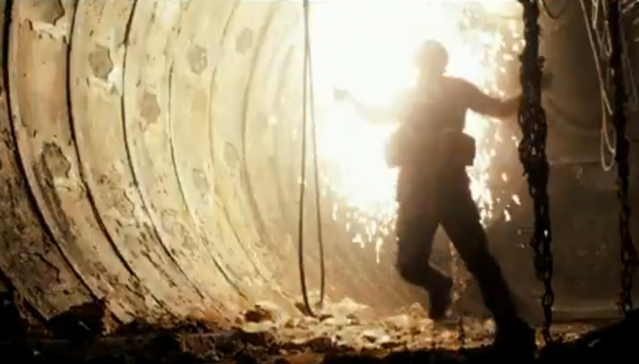
Those of us who were moviegoers in 1987 have a very soft spot in our heart for Predator, the magnificent dual-governor-to-be casted scifi-horror-monster flick. Today, two Predator fans take a look at the sequel, the imaginatively titled Predators. Earlier we heard from horror connoisseur Melissa Lafsky; now here’s action, gun and script expert Abe Sauer, who reveals that Predators actually could have ended worse.
“Reboot.” “Update.” “Brand recognition.” These terms always accompany the announcements of Hollywood’s latest try at turning nostalgia into dollars. After The A-Team and Clash of the Titans, RoboCop, Red Dawn, Highlander, Total Recall, Romancing the Stone, Red Sonja, The Fall Guy, The Equalizer, Footloose, The Black Hole, Death Wish, Escape from New York, and Tron are just a few of the in-the-works “reboots” of 1980s “properties.” Predators, in theaters now, is not a reboot. Then again, how was a studio going to make a “grittier, darker, more real” Predator for “our modern reality” when the predators of our modern reality are far more scary than the 1980s sic-fi headliner could ever hope to be? Similarly cloaked from plain sight, today’s predator is the neighbor waiting to rape your child or an unexpected, unmanned drone death from above.
Some spoilers follow
Released in 1987, Predator was directed by John McTiernan, who went on to direct Die Hard, the best straight-up action film of the 1980s (and maybe ever). It is the only action script commonly taught in screenwriting programs. Like Die Hard, Predator is a deeper film than its IMDb page suggests. While often lazily compared to other show beef action movies of the era (Roger Ebert wrote that the film “begins like ‘Rambo’” and Janet Maslin in The New York Times wrote “’Predator’’ starts out as a second cousin to ‘Rambo’’ and ‘’Missing in Action…’”), the film has far more in common with Jaws and Apocalypse Now. The scene where the soldiers fire blind, wild and panicked into the jungle at an invisible, unknown enemy mirrors the tiger sequence from Apocalypse. That, in 1987, Predator was seen by many to be a Vietnam allegory has been largely forgotten. In Predators, Robert Rodriguez & Co. makes his own nod to Coppola’s tale, but in characteristic fashion, it’s just a big fat joke.
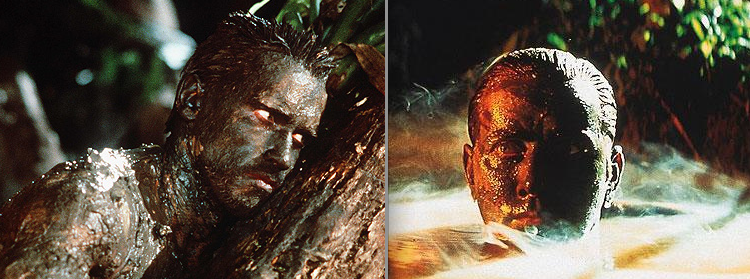
Predator was also subversive. At a time when Arnie and his ilk regularly fought Russians and terrorists, Predator’s underlying message was that Reagan-era agencies like the CIA were no better. It may have been morning in (Central) America, but for Mac, Blain, Hawkins, Poncho, Billy and Dutch, that fresh day’s sunlight was not visible through the tree canopy. More than any studio marketer could wish for, Predator debuted in theaters just as New York Times headlines read “Superiors Knew of Contra Help, C.I.A. Man Says.”
The Nimród Antal-directed Robert Rodriguez Presents: Predators is a sequel. But it is no true sequel. It is pastiche. Entire scenes are lifted more or less wholesale from the original and plunked into place, held together with a wink. Seemingly the only detail Rodriguez forgot to mimeograph was the wristwatch; while Adrien Brody sports a Hamilton Below Zero, one would have expected to see Seiko’s H558, Arnold’s favorite movie watch. It’s a detail one expects Rodriguez to know.
Otherwise, Predators borrows so heavily from the first film that any criticism almost needs to address it both as a sequel and as a reboot.
Has Rodriguez really worked on this project, on and off, for 15 years? It doesn’t show in the final product, which, despite all the junket comments to the contrary, borrows very little from the 1994 Rodriguez script. In interviews, Rodriguez typically claims that his original script was not produced because the technology was not yet available. It is more likely it was not produced because it is bullshit, exhibiting all the worst tendencies of the action genre sequel: Bigger, Faster. MORE. One scene in Rodriguez’s original script, set on a planet named Arkus 6, references “teen predators” and Harley-Davidson-like predator “Cyclesleds” which appear in an action sequence, only proving Mr. Rodriguez enjoyed a little “homage” even in his youth. The script stars the Arnold character “Dutch” and its difference from the original Predator can best be compared to the difference between the excellent Pitch Black and its insulting sequel The Chronicles of Riddick.
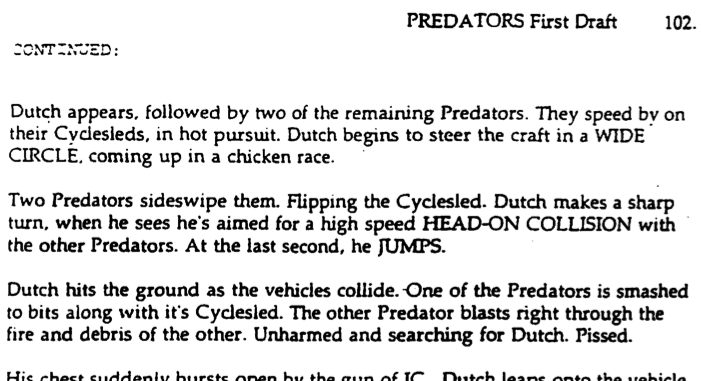
The Rodriguez script that did end up being the Predators film now in theaters is a major improvement on its ancestor. Yet it suffers the same miscalculation made by all subsequent Predator films: an assumption we want to know more about the Predators. It’s a mistake George Lucas made with Boba Fett, tragically believing the character’s popularity invited deeper plumbing of the bounty hunter’s persona. The misjudgment gave us a Fett-heavy prequel shambles.
Rodriguez’s Predators makes the same error, giving us more predator weapons, predator dogs, predator falcons and predator culture. And, of course, more predators. Too many predators. Too much variety. The second version of Rodriguez’s Predators script contains the lines “This is not your father’s Predator” and “Think Predator on steroids.” At the same time, Antal and Rodriguez have talked in interviews about wanting to humanize the predators. It’s Bigger. Faster. MORE. Mostly MORE. The original single predator handily eliminated a team “accused of being the the best” in one 24-hour period. Now we are to believe a rag-tag bunch of killers is going to fight off a whole hunting party of predators, their predator falcon and predator dogs? Certainly, Yakuza and Mexican cartel hit-men are true bad-asses, but today’s gentrified Yakuza are having enough trouble dealing with senior citizens, let alone alien masters of slaughter.
One specific example of how Predators tries for MORE but achieves less is the Yakuza character’s death, a scene clearly meant to replicate the original in which Billy gives up his flight, turns around on a log bridge, throws away his gun, draws his machete, and prepares to battle the beast, mano-a-mano. In the original, we never see Billy die, his scream just fills the jungle. In Predators, the Yakuza compatriot similarly gives up flight, disrobes and turns to face his sure death, a sword as his only weapon. This nod to nostalgia works until the scene continues onward, ending with a comical thrust-perry fencing duel that sucks all the tension and mystery out of the fun. The result is that these borrowed bits, these Predator but “on steroids” moments, only serve to exemplify the mediocrity of the homage.

Predators takes place on one of those convenient planets so often found in middling sci-fi, where alienness is confined to occasional prop-department contribution. It is also an open planet. Far too open. Predators opens in the air, with Royce, our new Dutch, falling, inexplicably, through the atmosphere, the wind in his hair. Even when the action movies into the jungle, rays of sunshine still find a way in. Tree trunks are tall and the foliage is largely at a distance. The jungle of Predators would make a nice place for a hike.
The original Predator’s atmosphere was a sweltering, equatorial nightmare that the audience felt in the seats, where bugs bit and damp clothing clung. Predator’s use of the jungle to create claustrophobic tension mirrored the use of the cramped ship in Alien, a film Predator itself could be accused of transcribing. For the characters, who visibly poured sweat throughout the film, and who never glimpsed the sky, Predator was a fever dream from which death might be, eventually, welcome. That film piled on the claustrophobia from the start, opening at dusk, moving tighter and tighter, from the cigar-smoke-filled low-ceilinged office shack to the op-red nighttime chopper ride. The only view we ever get outside the curtain of the jungle was the final, stupefied ride away into the numb void, where a deep breath was allowed and the expanse is finally visible, if pointless.
One of the seldom mentioned but never forgotten breakout stars of Predator was the weaponry. For gun buffs, Predator was a smorgasbord of Heckler and Koch appetizers with extravagant main courses. The film took run of the mill M16s and then strapped shotguns and grenade launchers beneath their bellies. The film also employed dramatic fire suppressors, which burped stars from the end of the barrel, turning normal gunfire into fireworks. Predators duplicates its predecessor’s gun-obsession not just with the mini-gun, but also a vast array of other exotics. From its own double H&Ks; to the Blaser sniper rifle to the run of the mill Baretta capped with a dramatic fire suppressor, Predators gets the NRA porn part right. (It’s worth noting that 1990’s Predator 2 got this right as well, loading its L.A.-as-war-zone scenes with overly-theatrical laser sight attachments, Desert Eagles, Steyr AUGs and Mossbergs.) Most importantly, Predators puts the AA-12 in the hands of its star, Brody. The AA-12 assault shotgun has a distinct look and a pedigree much deeper than its smooth and simple exterior. The New Yorker even deemed the weapon worthy a long profile last year.
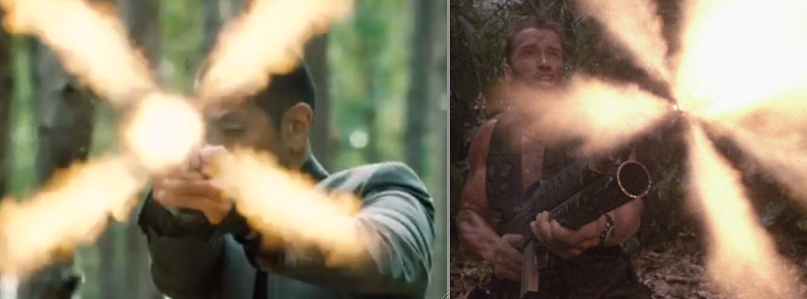
And of course, there was Predator’s unforgettably fun mini-gun (“Old Painless”) toted by Blain (Jesse Ventura). It’s a weapon whose extravagant idiocy has since become a staple of action grotesquerie, from Terminator 2 to the upcoming Machete (another Rodriguez film, the trailers for which already exhibit numerous recreations of bits from the director’s 1995 film Desperado, which was itself a remake of El Mariachi). Too bad Predators’ ode to the original’s mini-gun (a M134 instead of Ventura’s modified GE M134) is wasted in the first minutes, before the audience has an opportunity to anticipate its unboxing.
Like Predator, Predators also eschews CGI effects for old-school rubber-mold. It is a bold, brave bet for a modern action film to make. The Predator character could easily have been the Silly Putty-looking Ghost Rider. For this rare act of restraint alone, Predators deserves some credit; it’s credit Rodriguez hasn’t missed taking.
A side note about Danny Trejo: “That Guy” actor Danny Trejo shows up here, the reborn “El Scorpio” character from Predators 2, double-fisting machine guns and all. It’s no surprise to see him. Rodriguez has used him regularly, including in both Desperado and its sequel Once Upon a Time in Mexico, even despite Trejo’s character having died in the first film. It’s also no surprise to see him playing a character with no surname (Cuchillo). Since his 1995 star-making turn in Heat (in which he played a character named just “Trejo”), Trejo has had well over 100 roles, almost all as characters like Razor Charlie, Poacher, Scarface, Fred, Collins, Pierce, Vito, Jumpy, Slim, Machete, Pedro, El Jefe, Bob, Manny, El Patron, Cucuy, Raul, Papi, Harold, Rondo, Apache, Fury, Roy, Creek, Shady Chuck, Priest, Albert, Junk, El Chivo, Clint, Capone, Manolo, Perry, Barro, Captain Podrido, Mario, Esteban, Crazy Joe, Jimmy, and Tortuga. He has played a character with the one-word name “Hector” no fewer than five times. Brody’s character should have been killed early on with Trejo finishing out the film. Predator vs. Machete, a truly unique sequel.
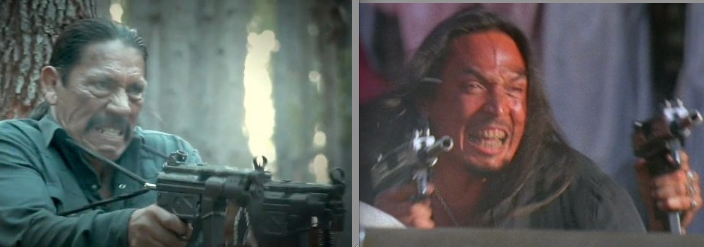
Despite victories with the guns, CGI and, Danny Trejo, Rodriguez and Co. get a big thing wrong, and it’s not Laurence Fishburne, who, looking awfully paunchy for having spent decades surviving on scraps, appears in a predator git-up reminiscent of Princess Leia’s Boushh bounty hunter disguise.
No, in all that has been copied from the original, what goes most wrong is a shame, because from all the publicity circuit raving both Rodriguez and Antal have done in the last two weeks about the original, it seems they fully recognize it.
It may seem antithetical, but the original Predator wasn’t successful because of the action or the special effects or the monster or even Arnold. It was about the give and take between the characters. The popularity of the whole film rests on the first 30 minutes. It is in these 30 minutes, from the chopper ride to when Blain breaks out Old Painless, that Predator’s popularity rests. It is all before the first bullet is fired. In fact, the 120 seconds in the helicopter early on in the film does more to establish the characters than most action films manage in 100 minutes. This chatter includes two great mood-lightening jokes.
Those jokes in the helicopter, in the first minutes of the film, are delivered by Shane Black, the famed screenwriter of Lethal Weapon, Last Boy Scout, Long Kiss Goodnight, Kiss Kiss Bang Bang, and the under-appreciated Last Action Hero. He plays Hawkins and after these jokes he will not speak again for the rest of the film. That we’re endeared to him in those moments is all on the strength of the dialogue.
This dialogue not only invests the audience in the cast but also makes us envy them. That opening has the language and cadence of every high school team on a bus on their way to every away game. The attraction to seeing Predator with your buddies is that, in your wildest imagination, that is you and them. Also, Predator’s humor was equitable, with characters giving as good as they got. Predators is hopelessly humorless. So much so that Topher Grace was hired as a humor mercenary to add snarky Eric Foremanisms at the expense of everyone, including the film.
That both Rodriguez and Antal failed to realize this is a pity. In numerous interviews both retell the tale of first seeing Predator in the theater, with buddies. Rodriguez says he saw it with his elder brother, who was a body builder at the time. Describing his first Predator viewing, Antal said, “Fourteen years old. Avco on Wilshire. Guido Martini, John McMann, Sean Ender, and Chris Alright and I. And I walked out going ‘Oh! Whoa!’” Antal was 13. Rodriguez was 18. (Rodriquez and I share the same birthday, by the way-June 20.)
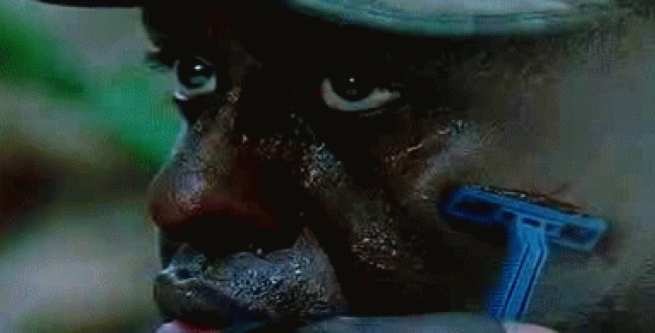
For Predators, Brody spent time preparing for the role by sleeping in the jungle, boasting, “I was isolating myself and studying tons of military manuals and learning tactics. I was spending time alone in the jungle.” Meanwhile, Rodriguez brags about preparing the backstories of all the characters. He tells of how the sniper character became what she is because of her rare ability to lower her heartbeat. But that cannot make up for the lack of character development onscreen. Having slept in the jungle a few times and being able to sit in a captain’s chair and excitedly talk about how the Yakuza character was born 1,000 years too late, and should have been a samurai, is nothing next to Bill Duke running a razor all over his sweaty head… and then breaking it. What the hell was that? That was awesome.
It’s telling that neither the fanboy community, nor Rodriguez, nor Antal, nor any marketing material even suggests that this film is better than, or even on par with, the original. Expectations are low, with “not an embarrassment” a totally acceptable measure of success. Predators is not an embarrassment. But the best that can be said about Predators is that it deserves a gold star for effort and could have been far, far worse. Case in point, the updated Rodriguez script for the current Predators includes an alternate ending page (below) which would have made Predators the most preposterously disingenuous action sequel of all time, a total bullshit psych-job.
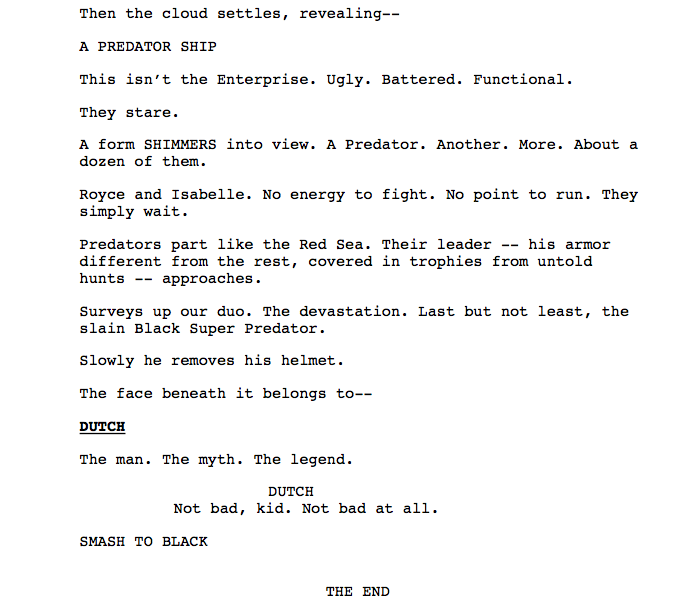
In the end, where Predators is most like the original, and most successful, is as a vehicle for its star. Just as the original was seen in its time as a vehicle for Arnold, so does today’s Predators exist solely as a vehicle for Robert Rodriguez. If there is one thing Rodriguez is better at than making movies it’s talking about making movies. Next up? Robert Rodriguez Presents: Red Sonja.
Not unlike the predator culture he has gone on about recently, Rodriguez is a trophy hunter. It is no stretch to imagine him and Tarantino sitting on a couch, shooting the shit about which genre from their youth to plunder next, while nearby lurks a life-size predator from the prop department, modified to hold a tray for their drinks.
Abe Sauer really, really likes Predator.
Prairie Voles Enjoy Getting Blitzed Just Like Humans
Prairie voles, so like us: “After chugging their preferred 6 percent alcohol drink (about the equivalent of beer), some thirsty voles shoved off parental responsibilities and even walked out on their mates. Though some drank responsibility, others drank to excess, stumbling away from the bar/spiked water bottle. The study suggests that like humans, the voles also make drinking buddies, seemingly encouraging each other to have another. When caged together, the voles appear to match one another drink for drink…”
Giant Sinkhole To Eat Tampa
Granted, it is a story about a sinkhole, but I’m still kind of amazed by just how many times they say “sinkhole” in this report. Sinkhole, sinkhole, sinkhole!
House Where Duke Lacrosse Players Did Not Rape Woman Destroyed
by Nate Freeman

It was just a white split-level a stone’s throw from dorms on Duke University’s East Campus, indistinct from the other worn-down frat pads littered throughout Durham. It had an iron-wrought railing that curved into leafy shapes, and behind that was a door with a metal knocker. The shutters were black and the roof was grey. But what set it apart was its address-a street number that conjured up a remembrance of the salacious accusations, the media frenzy and the turbulent bouts of protest. Today 610 N. Buchanan Road-the center of the Duke Lacrosse scandal that erupted in March 2006-was destroyed.
I matriculated to Duke as a part of the class of 2010. As a group, we decided on this university despite what can only be called turmoil on campus: protests by the New Black Panther Party on the main quad, an ad taken out in the campus paper by a group of professors proclaiming a “social disaster” on campus, and flashy cover stories in Rolling Stone and Newsweek that referred to Blue Devil-specific phenomena such as the “lacrosstitute” and the “Duke 500.” Three players on Duke’s lacrosse team had been accused of rape by exotic dancer Crystal Mangum, and this rape had supposedly occurred at a house steps from where we would spend our freshman year.
As the year went on, the truth about that night started to trickle out. The contradictory accounts shifted as the investigation continued, eventually resulting in the exoneration of the players and also ethics charges levied against District Attorney Mike Nifong. I had the opportunity to attend one of these ethics hearings as a reporter for the Duke Chronicle. I sat next to Reade Seligmann, one of the three players, along with Collin Finnerty and David Evans, accused. Seligmann was there with his lawyer and family members, watching the charges of false accusation get thrown at the embattled district attorney. I even ran into Nifong himself, first in the bathroom-where he took to washing his hands with an astounding vigor-and then after the day’s hearing, when I asked him a question for the paper (he declined to comment.)
But throughout these events the house stayed constant, languishing in vacancy. The University had purchased it just a month before the incident occurred, and had no choice but to leave it alone in case it became of use as evidence in the ongoing civil cases. So it stayed unoccupied and drab, photographed until it became iconic, its sides often dotted with exclamatory signs, its lawn attractive to protesters, gawked at by those who ambled by on their way to town.
In its last days the house was a relic. It’s been years since North Carolina Attorney General Roy Cooper dismissed all charges against the three players. There have been civil suits filed against the university by players, Nifong was disbarred and briefly imprisoned for his mishandling of the case, and Duke has for the most part shed its automatic associations with the incident. Instead of potential rapists, the members of the Duke lacrosse team are national champions, having beaten Notre Dame in this year’s N.C.A.A. final on May 31. Many of the players who led the charge for the Blue Devils were fifth-year seniors-freshmen when the scandal broke-who were granted eligibility by the N.C.A.A. because the 2006 season was canceled. The victory did much to break down the perception that still lingers in discussions of Duke lacrosse, and now that the University decided to raze the house at 610, the last symbol of the incident is gone from the Bull City. It will, at least, no longer gnaw at the administration as a constant reminder.
The act of destruction itself was appropriately anticlimactic. A friend of mine-a member of my class spending the summer in Durham-happened to pass the carnage while going on a run around campus, and didn’t take more than a glance until he recognized the house’s frame as the one printed in newspapers all over the country. “Well, to be honest, it just looked like any old house getting knocked down,” he wrote me on gchat. “It took a couple seconds for it to dawn on me what house it was. I just thought, ‘Oh yeah, that was the lacrosse house,’ and that was it.”
That’s the way many Duke grads my year would react. We arrived too late for the firestorm, and instead experienced the recession of ire that emerged after the innocence became clear, series of apologies and the eventual fallout and rebuilding of the Duke brand. It affected us in a way that extended little beyond the world of small-talk; for those months, when we told people we were going to Duke, we would get shit from kids our age and disapproving tut-tuts from mothers. To many of us, the entire case is now a memory of these exchanges-nothing more than awkward moments, occurrences that, as high schoolers, we were all too accustomed to-and the house’s demise makes these exchanges even more distant.
And it was just a house. Maybe when walking by I indulged for a second in curiosity, pictured the rooms beyond those walls, and tried to imagine what really happened that night of March 13. But when the wrecking crew came today the house was already a specter-it was already barely there, already more a memory than a place. It had been empty for so long.
Sonia Sotomayor Follows in Clarence Thomas' Footsteps (And Sells Memoir)
We know one person Sonia Sotomayor’s going to be like on the bench. Surprise, it’s Clarence Thomas! Because they are both memoir whores. Even more so than vice-presidential literature, can any other genre of memoir be more sanitized and less of interest to the present or history?
Man Furious About Having To Dress Correctly
“”Women can get away with wearing shorts to work, but men can’t. I have an issue with that,” says some guy who, as a designer, SHOULD TOTALLY KNOW BETTER.
Soccer-Predicting Octopus Inspires Revenge Killing

“AN Argentine TV presenter furious with Paul the ‘psychic’ World Cup octopus has horrified viewers by liquidising one of his relatives live on air…. Argentina fans blamed [Paul the octopus] for their World Cup exit after he correctly predicted Germany would beat them and some have voiced a desire to eat him. So after branding the animal a ‘Nazi’ [presenter Roberto Pettinato] grabbed an octopus live on air and claimed to be killing it as he hacked its head off and put bits of it in a blender.”
Silvio Berlusconi Zips Up
Sad news for Italian prostitutes: Prime Minister Silvio Berlusconi says his playboy days are over.
